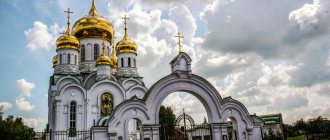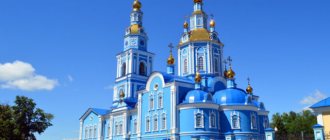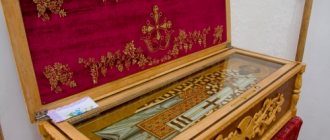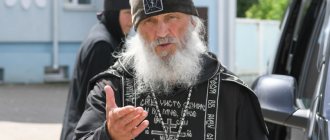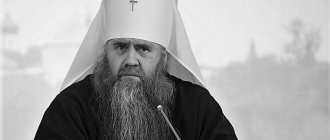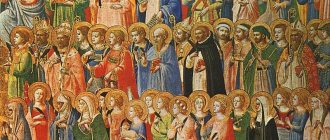| Simferopol Peter and Paul Cathedral |
Simferopol and Crimean Diocese
of the Ukrainian Orthodox Church
- Diocesan administration: Russia, 295011, Republic of Crimea, Simferopol, st. Geroev Adzhimushkaya, 9/11
- Tel.: 7 (978)-733-85-29; fax: 25–14–70
- Official site:
- Canonical territory: gg. Simferopol, Alushta, Evpatoria, Yalta, as well as Bakhchisarai, Belogorsky, Kirov, Saki, Simferopol and Black Sea districts of the Republic of Crimea and the city of Sevastopol
- Cathedrals: Peter and Paul and Alexander Nevsky in Simferopol
- On the map: Yandex.Map, Google map
Early Christian period and the rise of Byzantium
For the Russian lands, Crimea is the cradle of Orthodoxy - the holy apostles Andrew the First-Called and Simon the Canaanite, the Equal-to-the-Apostles brothers Cyril and Methodius preached here, and the Equal-to-the-Apostles Grand Duke Vladimir received holy baptism here.
After the establishment of independent cathedras in Crimea by the beginning of the century, Orthodox hierarchs remain on the peninsula almost without interruption. Already in the year, Saint Clement of Rome was exiled to Crimea, which was then a place of exile on the outskirts of the Roman Empire, for hard work, and, according to the chroniclers, he found more than 2,000 Christians here. By the time of his martyrdom in 104, there were 75 Christian communities in different places of the peninsula, which had temples for prayer carved into the mountains and preserved to this day. The oldest can be considered Inkerman, where Saint Clement was exiled. Numerous martyrs suffered in Crimea in those days. Abodes of monks appeared in mountain caves already in the centuries.
Soon a number of dioceses were formed in Crimea - by the time of the First Ecumenical Council in 325, the Bosphorus and Chersonesos (Korsun) dioceses existed; in the same century the diocese of Fula was established; about a century the Gothic (Gothic) department moved to Crimea; and no later than the beginning of the 8th century, the Sugdey (Sourozh) diocese also appeared. Thus, during the heyday of Byzantium, there were five dioceses on the peninsula, with centers in the ancient Greek colonies on the southern coast and in Gothia, the land of the Goths who moved here, then were mostly ousted by the Huns. The dioceses were under the jurisdiction of the Patriarch of Constantinople.
Waves of conquest
Politically, despite the fact that the Eastern Roman Empire held at least part of the sea coast until the fall of Constantinople in 1453, it was constantly adjacent to different, often hostile and heterodox peoples. En masse, the Goths who accepted Arianism for a long time retained statehood in the Principality of Theodoro. Then the Huns came, in the 8th centuries, the Judaist-Khazars conquered the peninsula, and after the defeat of the Khazar Kaganate, Karaite communities fled here. Waves of invasions of Turkic tribes (Obrov-Avars, Turkic-Torks, Kipchak-Polovtsians) continued continuously for three hundred years and ended with the conquests of the Mongol hordes in the 13th century. Around 1380, the southern coast of Crimea and Gothia were captured by the Genoese. By the 12th century, there were three dioceses here: Sudgei-Fula, Chersonesos and Gotthaea, under the jurisdiction of the Patriarchs of Constantinople. In 1394, the Chersonese diocese was annexed to the Gothic diocese.
In the century, the Turks, with the help of the Tatars, captured southern Crimea, and the peninsula became part of the Crimean Khanate as a vassal of the Ottoman Empire. In 1485, a new Kafa diocese was formed, while, according to some sources, Sourozh was annexed to Gotthi [1]. By the end of the 17th century, the Kafa diocese was also annexed to the Gotthian diocese, and only one see remained in Crimea. The Gotthian hierarchs ruled the oppressed flock of Crimea until the exodus of most of the Orthodox in 1778, led by Metropolitan Ignatius (Gozadini) of Gotthia, into the Russian Empire.
As part of the Russian state
In April 1784, the lands of the Crimean Khanate annexed by Russia in 1783 became part of the Slavic diocese. By this time, most of the churches and all the monasteries were abandoned and looted, because... The Orthodox population en masse left for Russia several years earlier. The Gotthian diocese continued to exist as part of the Slavic diocese until 1786, after which it received the semi-independent Feodosian vicariate until 1799.
Between 1799 and 1859, Crimea did not have its own Orthodox bishop and the peninsula was ruled by the Ekaterinoslav (formerly Slavic) rulers, and from 1837 by the Kherson rulers. At first, due to the influence of secular “enlightenment,” Russia did very little to Christianize the region. In the first seventy years of Russian colonization, nothing was done to revive Christian shrines from the era of the rule of the Orthodox Eastern Roman Empire, although the ruins of ancient churches and monasteries remained everywhere. At the same time, the government contributed to the settlement of the region by heterogeneous foreigners, in large numbers by sectarians and schismatics, and for about fifty years after the annexation, Islam remained the dominant religion there.
The situation changed only in the middle of the 19th century, when the Holy Synod received the opportunity to restore old monasteries here and found new ones. By the highest resolution of November 16, 1859, at the request of the residents of Crimea, an independent Tauride diocese was established on the territory of the peninsula, being separated from the Kherson diocese. With the formation of an independent diocese, church life began to expand rapidly - in less than ten years, more than a hundred new parishes appeared, monasteries intensified their activities, and men's theological schools were opened. Under Saint Guria (Karpov), the Tauride Theological Seminary began its work, and the magazine “Tauride Diocesan Gazette” began to be published.
After the outbreak of revolutionary unrest in 1917, testing times came for Orthodoxy throughout the former Russian Empire. In the 1920s and 30s, the Church in Crimea was subjected to severe persecution: monasteries and churches were closed, thousands of believers and priests were repressed.
From 1922 to 1933 there was also a Simferopol renovationist diocese.
Within the Ukrainian Orthodox Church
Orthodoxy in Crimea began to revive only in the late 1980s. The restored Simferopol diocese included the entire territory of Crimea until the separation of the independent Dzhankoy diocese in the north of the peninsula by the decision of the Holy Synod of the Ukrainian Orthodox Church on November 11, 2008.
On December 20, 2012, the independent Feodosia diocese was also separated from the Simferopol diocese within the boundaries of the Feodosia and Kerch deaneries.
Historical names
- Tauride and Simferopol (November 16, 1859 - ? 1920s)
- Simferopol and Tauride?
- Simferopol and Crimean (since 1944)
Statistics
- January 1, 1958 [2] - 48 registered temples/houses of worship.
- 2000 - 350 parishes, 8 monasteries [3].
- OK. 2004 - 483 parishes; 281 clergy [4].
- January 1, 2008 - 532 parishes, 9 registered monasteries and 7 under registration; 70 temples and 462 houses of worship; 19 deaneries [5].
Archpastors
- Elpidifor (Benediktov) (January 7 - May 25, 1860)
- Alexy (Rzhanitsyn) (August 29, 1860 - August 28, 1867)
- St. Gury (Karpov) (November 28, 1867 – March 17, 1882)
- Ermogen (Dobronravin) (April 24, 1882 - March 9, 1885)
- Alexy (Lavrov-Platonov) (March 9 - May 11, 1885)
- Martinian (Muratovsky) (May 11, 1885 - January 19, 1897)
- Mikhail (Gribanovsky) (January 19, 1897 - August 19, 1898)
- Nikolai (Ziorov) (September 14, 1898 - March 26, 1905)
- Alexy (Molchanov) (March 26, 1905 - November 5, 1910)
- Feofan (Bystrov) (November 19, 1910 - June 25, 1912)
- St. Dimitri (Abashidze) (June 25, 1912 – ca. 1921)
- Sschmch. Nikodim (Krotkov) (1921 - 1924)
- Alexander (Raevsky) (1924 - March 19, 1928) high school bishop. Kerch
- Dionysius (Prozorovsky) (November 29, 1928 – June 25, 1930) senior, bishop. Feodosia
- 1931 - 1944 - widowhood of the department
- Feodosius (Protsyuk) (July 19 - October 8, 1965) senior, bishop. Poltavsky
Further decoration and improvement of the cathedral
In 1890, with money collected from donations from local residents, the cathedral was surrounded by an openwork cast-iron fence, and the adjacent square was landscaped, which became the site of various city events. In the same year, a decree was issued according to which development of the surrounding area was permitted only with buildings whose size did not exceed the height of the cathedral.
At the very beginning of the new 20th century, significant changes were made to the decoration of the temple. With donations from the church warden, master painters were hired to paint the dome with the image of the figure of the God of Hosts surrounded by the Heavenly Powers, and in the lower part of the drum they placed twelve medallions with the faces of the holy apostles. The picture was complemented by floral patterns covering the walls.
Geography of deaneries
- I Simferopol (); II Simferopol:
- Simferopol, village. Beloglinka, s. Vinnitskoe, town. Gvardeiskoye, village Good, s. Donskoye, s. Dubki, s. Ivanovka, s. Kolchugino, s. Krasnaya Zorka, s. Mazanka, s. Mirnoe, town. Molodezhnoe, s. Nikolaevka, s. Novoandreevka, s. Novoselovka, s. Partizanskoe, p. Pervomaiskoe, village Perevalnoe, village Perovo, s. Pionerskoe, p. Pozharskoe, village Rodnikovoe, village Skvortsovo, s. Sofievka, s. Ukromnoe, s. Urozhaynoe, s. Chistenkoye, Shkolnoye village
- Alushta, Malorechenskoye village
- Bakhchisarai, s. Kuibyshevo
- Evpatoria, town. Zaozernoye, village Kirovskoe, village Medvedevo, town. Mirnoe, town. Novoozernoe, village Olenevka, town. Chernomorskoe, village Shtormovoe, s. Suvorovo
- village Kirovskoe, village Aromatnoye, Belogorsk, Stary Krym, village. Topolevka
- Saki, s. Frunze, s. Cozy, s. Dairy
- Sevastopol, s. Ternovka, s. Navy
- Yalta, Alupka, Gaspra, town. Gurzuf, town. Koreiz, Krasnokamenka village, Livadia village, Massandra village, Oreanda village, town. Simeiz, town. Foros
Construction of the main cathedral of the diocese
The Peter and Paul Cathedral, which is of significant historical and artistic value, deserves special attention. According to archival data, it was founded in 1866 on the site of the wooden Church of Saints Helen and Constantine, which had fallen into extreme disrepair. The author of the project and the manager of the work was the Simferopol architect K.P. Lazarev.
The construction and decoration of the cathedral took about four years, after which it was solemnly consecrated, and regular services began there. It should be noted that long before this, in 1668, two schools had already been opened at the temple - men's and women's. They existed until the beginning of the Bolshevik persecution of the church.
Monasteries
- Alushtinsky Kosmodamianovsky (male)
- Balaklava Georgievsky (male)
- Bakhchisarai Uspensky (male)
- Inkermansky Klimentovsky (male)
- Mangup Blagoveshchensky (male)
- Toplovsky Trinity-Paraskevinsky (female)
- Simferopol Trinity (female)
- Skalistensky Lazarevsky (male)
- Kholmovsky Nikolsky (male)
Also on the territory of the diocese is the stauropegial Sevastopol Paisievsky Monastery
Organization of pilgrimage trips
Nowadays, in the Crimean diocese, revived after long decades of total atheism, religious life has regained its former strength. Among the many departments of the diocesan administration, the pilgrimage service occupies a special place. Its employees organize trips, the program of which includes visits to temples, monasteries and various ancient Christian monuments, with which this fertile region is so rich.
In addition, the proposed travel routes make it possible to combine visits to holy places with relaxation by the sea in the most picturesque corners of the peninsula. The pilgrimage service accepts advance orders from both individual citizens and large groups. In this case, the starting point of the trip can be any city in Crimea. Those who wish can obtain all the necessary information on the diocesan website.
Literature
- Rodionov M., Statistical-chronological-historical description of the Tauride diocese: General and private review
, Simferopol, 1872. - Hermogenes (Dobronravov), Tauride Diocese
, Pskov, 1887, [2], 524 pp., 1 sheet. table - Church Gazette, Addition
, 1895, № 40, 1385-1386. - Durnovo, Hierarchy...
, vol. 1, 118 (note 1), 220; vol. 2, 213. - Pokrovsky L.P., Address-calendar for the Tauride Diocesan Department for 1912
, Simferopol, 1912, 363 p. section pag. - Tour V., Orthodox monasteries of Crimea in the 19th - early 20th centuries.
, Kyiv: Stylos, 2006.
The emergence of Christianity in Crimea
The history of the Christianization of this vast Black Sea peninsula is very interesting. As is clear from the Holy Scriptures, where the Crimean diocese of the Moscow Patriarchate is located today, the Apostle Andrew the First-Called once preached the Word of God, and later the holy brothers Cyril and Methodius carried the light of enlightenment. When Saint Clement of Rome was exiled to Crimea in 96, then, according to his testimony, the Christian communities there included more than 2 thousand people.
The light of Christ's faith shone unquenchably over the peninsula even during periods of difficult historical conflicts, for example, the capture of its northern part by the Tatar-Mongols, which occurred in the 13th century, or the annexation of the southern coast by the Genoese, who invaded a century later. When in 1784 the territory of the Crimean Khanate was annexed to Russia, it became part of the Kherson and Slavic diocese, the department of which was then located in Poltava.
How “Archbishop” Clement destroyed the “Crimean Diocese” of the OCU
On Tuesday, the head of the schismatic structure of the OCU in Crimea, “Archbishop of Simferopol and Crimea” Kliment (Kushch), declared an indefinite hunger strike near the building of the Cabinet of Ministers of Ukraine, demanding that the authorities stand up for the rights of the OCU believers in the “diocese” under his jurisdiction.
In front of television cameras, the “archbishop” demanded a meeting with the Prime Minister of Ukraine, who in the form of an ultimatum was given a period of a week to take specific measures, otherwise “I will be taken out of Kyiv in a coffin.”
Having assumed the aura of a martyr, he, however, added that he intended to suffer every day from 9:00 to 16:00, and apparently decided to spend the rest of the time in prayer vigil. Representatives of the media, it seems, were not imbued with the highly spiritual component of the feat of the last Ukrainian patriot in the occupied Crimea and simply forgot about it, since for two days there has been no news about the continuation of the action of the “bishop crying out to the Cabinet of Ministers.” The authorities also remain silent, and the Primate of the OCU Epiphany-Dumenko had to take the rap for everyone, commenting on the situation on his Facebook: “He (Clement - approx.) has been asking for a simple thing for years - for the state of Ukraine to transfer the building of the Cathedral Church of Saints Vladimir and Olga in Simferopol into the ownership of the Crimean Diocese of the OCU. Because for now this property is only rented - it is more difficult to protect legally, primarily at the international level. And the occupiers take advantage, “squeezing” the community and the diocese out of the premises.”
As we see, at the forefront of the problem is the notorious property issue - a five-year lawsuit between the “archbishop” and the Ministry of Property and Land Relations of Crimea for the right to own a building in the center of Simferopol on the street. Sevastopol, in which schismatics organized the “Cathedral of Saints Vladimir and Olga.” A three-story building with a total area of 1500 sq. m. in 2002 at the insistence of the President of Ukraine L.D. Kuchma’s Ukrainian schismatics, then still the Kiev “patriarchate” of the UOC, were rented for ridiculous money - 1 UAH. in year!
Initially, it was planned that on the basis of the premises, in addition to the “cathedral”, a kind of spiritual and educational center would be created, from where the trends of Ukrainian culture should find a favorable response in the hearts of Crimeans. Apparently, Leonid Danilovich was haunted by the idea of the Ukrainization of Crimea.
And in 2004, the Crimean Orthodox Spiritual Center LLC was registered at this address, the founder of which is the “Management of the Crimean Diocese of the Ukrainian Orthodox Church of the Kyiv Patriarchate,” which is headed by “Archbishop” Kliment.
Work began to boil, but instead of Ukrainian educators, the “church” premises were filled with the spirit of mammon - offices of commercial structures, a pharmacy and a candy store appeared in it. But really, why be surprised? Lively place, excellent transport links. Well, how can you resist the trend of modernity - you can’t feed on the Holy Spirit.
For a long time it seemed to Clement that everything was going smoothly and cloudlessly, his old age would be secure, and he had not forgotten about his relatives. But in 2014 the Russian Spring broke out. Crimea returned to its native land and the new authorities obliged all religious organizations to bring their documents into compliance with the legislation of the Russian Federation. In addition, in 2014, the lease agreement for the premises was expiring, and officials informed the LLC of the new terms for extending the lease.
And then the “archbishop” expressed his principles, they say, Crimea is now an occupied territory, and there can be no dialogue with the occupiers... and instead of legal re-registration of the OCU KP, he again registered Crimean Orthodox Spiritual Center LLC - with the right to conduct commercial activities. And Kushch’s principled position did not prevent him and his relatives from being among the first to obtain Russian citizenship.
It’s not for nothing that the elders say, “Whoever the Lord wants to punish, he deprives of reason.” Having succumbed to the cult of mammon, Clement seems to have lost his common sense. Refusing to exist within the legal framework of the Russian Federation, schismatics began to lose churches on the territory of the peninsula. First, they were expelled from the territories of military units, which is generally logical - members of a hostile structure have nothing to do at secret facilities.
Clement immediately announced persecution, they say, they are being persecuted because prayers are offered for Ukraine and its army in the churches of the UOC-KP.
Kliment could not lose the tasty morsel in the form of a “cathedral” in the center of Simferopol and entered into legal battles with the Ministry of Property and Land Relations, while at the same time constantly screaming at international meetings about the persecution and oppression of the “occupation regime”, trying to give a political overtone to the property dispute .
With the advent of the Tomos, only the abbreviation changed from the UOC-KP to the OCU; Kushch retained his position and continued the litigation. Having lost in court in all instances, the premises of the pharmacy and store were sealed by bailiffs. And then Clement realized that it would still not be possible to fight the Russian themis without registration, and this spring the principled position of the “archbishop” has undergone changes. He submitted the necessary documents to the Ministry of Justice, but something was wrong with them, and he was refused.
Meanwhile, the already small number of UOC parishes in Crimea continued to decline. At the time of the entry of the Republic of Crimea into the Russian Federation, the “diocese” of the UOC-KP consisted of about twenty parishes, but after that the number of parishes sharply decreased to six. The fact is that most parishes existed only on paper and were a source of funds. Despite the fact that the bulk of the “priests” who cared for the region came from western Ukraine, many were considered local activists and took an active part in Euromaidan. Therefore, it is not surprising that after the historical reunification, most of them chose to leave the peninsula.
But the main contribution to the disorganization of the activities of the “diocese” was made by its permanent leader.
At the moment, Clement has three parishes, if you can call them that - two equipped churches in rural private houses and a monastery, in which, however, only one monk lives - “abbot” Domian.
Left with nothing and having lost the support of even his own parishioners, the “archbishop” began to travel around the cities and towns of Europe and the United States, calling on the international community to put an end to repression and return religious freedoms to Crimea. At the same time, forgetting to mention that the only reason for all the troubles is his disregard for Russian legislation, an attempt to acquire some political preferences through scandals and false accusations against the Russian leadership.
Returning from a European tour, having slurped unsaltedly (there are plenty of similar clowns there), he resorted to a gesture of despair - the last shocking thing in the center of Kyiv, the effect of which, as we see, is zero.
Oleg Krivorotov
Period of barbarism and desolation
In 1924, the new authorities closed the cathedral, and at the same time renamed the Petropavlovskaya street leading to it, giving it the name Oktyabrskaya. Soon its re-equipment, or rather barbaric destruction, began. The dome and the cathedral bell tower were completely destroyed, and the interior began to be used as a warehouse, as a result of which a concrete ramp was built to allow trucks to enter it. Old-timers of the city remember the pitiful appearance that this once revered shrine had during the Soviet period - without a dome, with torn dirty walls and a tree growing on the roof.
Getting back to square one
The revival of the temple, as well as the entire diocese as a whole, began during the years of perestroika. Thanks to the works of the architect O. I. Sergeeva, in the archives of the Holy Synod it was possible to discover the very drawings according to which the lost elements of the cathedral were once built - the dome and the bell tower. This find allowed restorers to restore them with extreme precision.
Upon completion of the work, the temple was re-consecrated, and worship services resumed within its walls. In 2003, the Peter and Paul Cathedral was given cathedral status. It should be noted that new trends also affected the area adjacent to it - in 2008, by decision of the city authorities, the cathedral square and the street leading to it were returned to their historical names. From now on they are called Petropavlovsk.

